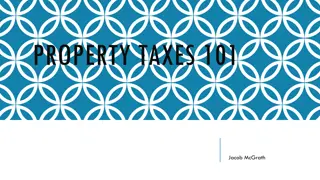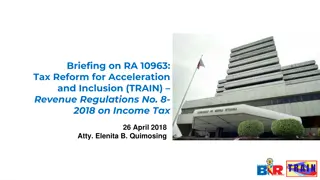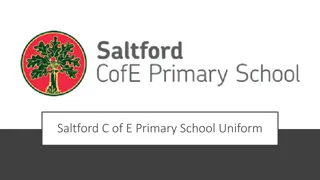Discussion on Uniform Mills for Property Tax Reform
The meeting of the Property Tax Taskforce Education Subcommittee discussed the proposal for uniform BASE mills to address the inequitable distribution of state funds among school districts. Previous studies recommended statewide levies to fund school district budgets. The debate focused on the benefits of uniform vs. variable BASE mills to ensure fair taxation and funding for education across Montana.
Download Presentation

Please find below an Image/Link to download the presentation.
The content on the website is provided AS IS for your information and personal use only. It may not be sold, licensed, or shared on other websites without obtaining consent from the author. Download presentation by click this link. If you encounter any issues during the download, it is possible that the publisher has removed the file from their server.
E N D
Presentation Transcript
Property Tax Taskforce Education Subcommittee, May 23, 2024 Meeting Discussion of uniform mills (statewide and county alternatives) to replace variable BASE Levies Prepared/Presented by Lance Melton, MTSBA Executive Director 1
Topic 1: Uniform General Fund BASE Mills A Proposal for Uniform BASE Mills Uniform Mills Will Cure an Existing, Inequitable Distribution of the State s Share. Because the state requires an interdependent system of local variable mills and guaranteed tax base aid by law, this mechanism in the funding formula can be argued to be part of the state s share for which the state is constitutionally responsible for an equitable distribution. Uniform Mills for Education are constitutionally-compliant. The state's power to levy a uniform property tax with the avowed purpose of providing support for education has been specifically upheld by the Montana Supreme Court in State ex rel. Woodahl v. Straub (1974). 2
Previous study recommendations 2001 K-12 Public School Funding Advisory Council 1. Created by HB 625, 2001 Session (Rep Musgrove, Havre, D.). 2. Recommendation #1: The Committee rejected countywide uniform levies in favor of a statewide levy to fund the BASE budgets of school districts. Coal, oil, and gas revenues would be used to offset the statewide levy and all other nonlevy revenue would be put into the over-BASE budget of a district. 3. The Committee also recommended a 5-year phase-in of the statewide levy. 3
The Arguments for Uniform vs. Variable BASE Mills Previous study recommendations 2003 Public School Renewal Commission 1. Created by House Bill 736, 2003 Legislative Session (Rep Roy Brown, Billings, R.) 2. The Public-School Renewal Commission recommended Implementation of a statewide equalization plan with an emphasis on homeowner equity and uniform property taxation. 3. The proposal called for funding the base budget using statewide equalization. 4
What are BASE mills? BASE mills are neither permissive or voted; they are statutory/formulaic BASE GTB squeezes them down in low-wealth school districts to some degree, but significant variation in these required mills remains Equalizing BASE mills would replace the current portion of the funding formula filled with GTB and local BASE mill levies with either state funding (through statewide equalization) or county funding (through countywide equalization) 5
The Arguments for Uniform (State or County) vs. Variable District BASE Mills 1. The disparity in taxable values per pupil across Montana remains profound, varying from a low mill value of only 30 cents per ANB to a high of $2,765 per ANB. This is a taxpayer equity gap of over 8,000 percent that could be cured with greater uniformity in BASE mills. 2. Current BASE mills, which are required by law as needed to fund the BASE budget, vary from 0 to 51 mills despite the state already investing $250+/- million annually to equalize tax effort across all districts through GTB. 3. Because of the interdependence of guaranteed tax base aid and local BASE taxes, understanding the school funding formula is near impossible. The lack of transparency generates distrust and understandable confusion, even among those responsible for levying the taxes. 6
Option 1: A Revenue-Neutral Proposal to Replace Local Variable with Uniform Statewide Mills 1. Assume $4.6 million revenue per statewide mill, using estimates from House Bill 587 fiscal note. 2. FY24 variable district BASE levies generate $164 million. 3. 18 uniform elementary and 18 uniform high school mills (total of 36 uniform mills) would generate approximately $165 million per year. The revenue would be used to eliminate local variable district mills in the school funding formula. 4. Remit the revenue from these mills in the same way and to the same destination (HB 587 account) and the BASE budget would now be funded entirely by the State for each district without the complications of calculating DSA, GTB, etc. Minor amendments to HB 587 would be needed. 5. Uniformity in BASE mills reduces mills in 223 school systems educating approximately nearly 90% of the state s students. Assuming that residential property taxpaying individuals live in similar proportion to where children are enrolled in their public schools, mills would go down for nearly 90% of Montana property taxpayers by using uniform statewide instead of variable local BASE mills as a funding source for school district general fund budgets. 7
Option 2: A Revenue-Neutral Proposal to Replace District Mills with County Mills 1. This proposal would yield a funding formula comparably complex to the current funding formula but would reduce the variation among approximately 400 school districts to smaller variations among 56 counties. Wide disparities in tax wealth per pupil, however, exist among different counties, at more than 4,000% from high to low. Nonetheless, that is half the disparity that exists among districts under current law, so presumably a GTB mechanism would work twice as well at a county level than it currently does at a district level but would still have significant variations in tax effort from county to county. 2. Sub-options Use the current GTB formula and ratios for school district general fund levies and apply it among 56 counties. To ensure revenue-neutrality, the law would have to be amended to establish a ratio that generates approximately $250 million in county GTB support (same as current law). Abandon the general fund GTB formula and adapt/overhaul/expand the countywide retirement levy GTB formula. To ensure revenue-neutrality, the law would have to be amended to establish a ratio that generates approximately $250 million in county GTB support (same as current law) for county general fund BASE levies. 8































